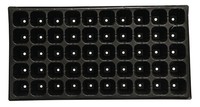 Loading... Please wait...
Loading... Please wait...Save Money. Grow Your Own!
Fast Plain Box Shipping.
We ship to the US & Canada.
Grow Your Own!
Germinating in Hydro: Beginner Guide
Posted on 11th Apr 2016
Are you just getting started in hydroponics? Want to know about the very first step to starting out on the path to fully mature plants?
No matter what you’re growing, the first step is germination. There are a number of ways to approach germination, but in this guide, we're going to cover germinating from seed, not the more sophisticated practice of harvesting plants from clones or cuttings.
Here are some steps to the process that beginners can follow to get started quickly and start to enjoy looking at their new plants grow.
Pick your seed stock
The first step to germinating seeds in hydroponics is to get the kinds of seeds that you want. Now, the philosophy of hydroponics is built on precision -- you pick the specific nutrients plants digest, the ways in which they grow, and the ways that your finished produce turns out. So you want to put a lot of thought into the types of seeds that you use.

With hydroponics seeds, or seeds for any other type of growing, you have some options. You can choose traditional seeds, hybrid seeds, or genetically modified seeds. Many growers stay away from GMOs because they want their products to be as natural as possible, being that they will also be untainted with the types of heavy and caustic chemicals that big ag businesses spray on GMO plants.
In any case, you can also choose to get locally produced seeds, or packets shipped in by some retailer. You also have to pick your crops -- what kinds of plants will you be growing and how does your space accommodate that?
Start putting together materials
As you're building your hydroponics space, you also start to look at how to germinate plants. Now, you will have all of this other stuff handy, too:
- growing tower
- irrigation tubes
- structural components
- reservoir
- plant pots
As far as the first step, there are certain specific things that you'll need for germination. You will either need some type of media to guide plants, or something like starter plugs.
Starter plugs are one of the easiest solutions for germination. You can get these in bags of 50 or 100 or some other number. You simply pop one or more seeds into each of the starter plugs, and you have the setup that you need for germination.

If you're not using starter plugs, you can choose between different grow media. Plants can just as easily be germinated in soil and then transplanted into a pot. Alternately, you can use grow media such as rock wool, coco coir and others. It doesn't really matter what you use to germinate plants. That grow material is just an inert substance that gives the seed cover while it is being nurtured. For example, you can put seeds in rockwool slabs, or you can cover them with crumbled rockwool pieces. Another choice is to use starter packs that use soil for covering the seed. However, this is tricky for hydroponics because as the root systems developed, they will be developed in soil, so then when you move them, there will be residual soil there. For this reason, growers might choose growing media instead, or take a conventional starter kit and fill it with something like rockwool instead of soil.

Set up germinating conditions
In order to properly germinate, seeds should be at around room temperature. You want a stable place for them to sprout, which is why a lot of people use these starter packets or starter trays. What you don't need is light -- plants don't have to be situated under grow lights for germination phases.
Keep seeds moist
While you don't need to conventionally water these plants, you do want to spray a little water onto them just to keep them moist as they sprout. Some growers use spray bottles to do this -- but you don't need to spray bottles to contain nutrients, because the plants aren’t really digesting. Think of germination as just an easy starter process where plants don't need too much to thrive. Over a period of time, you'll see those tiny little green shoots. Then you'll have plenty of time to transplant the plants and start giving them the light and nutrients and irrigation and everything else.
These are some helpful steps to getting germination right. As with any stage of the hydroponics process, there are a variety and wealth of ideas and concepts you can use to grow your plants. You don't have to do it anybody else's way, but you can take a lot of support from guidelines and standard practices that fit your needs. Think about using any of these types of approaches for germination and prepare for the next steps of your hydroponics process.
